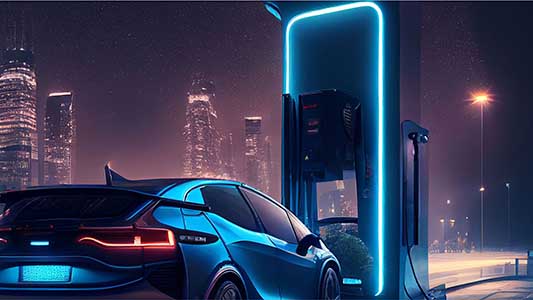Introduction
The global automotive landscape is undergoing a profound transformation with the widespread adoption of electric vehicles (EVs). This shift is driven by the urgent need to combat climate change and reduce greenhouse gas emissions. At the heart of this transition lies the pivotal role of a robust and efficient charging infrastructure. In this extensive article, we delve into the current global challenges and opportunities in EV charging infrastructure, with a particular focus on India’s vital role in advancing DC (Direct Current) charging powered by renewable energy resources to attain true zero carbon technology.
The Global EV Landscape
The electric vehicle industry is at a pivotal juncture, with momentum building worldwide. Leading automakers are pledging to phase out internal combustion engines, and governments are imposing stringent emissions reduction targets. Consequently, the global EV market is witnessing exponential growth, driving the demand for robust charging infrastructure.
Challenges in EV Charging Infrastructure
- Charging Infrastructure Disparity: A primary challenge in the EV ecosystem is the stark disparity in charging infrastructure development between regions. While some areas boast a well-established network of charging stations, others lag significantly behind. India, with its vast geographical expanse and diverse population, grapples with this challenge on an amplified scale.
- Energy Source and Carbon Footprint: An overarching concern is the source of electricity used for EV charging. Currently, a substantial portion of EVs worldwide is charged using electricity generated from conventional fossil fuels. This practice can negate the environmental benefits of EVs. India, like many nations, faces the imperative to address this issue to achieve genuine zero carbon technology.
- Charging Speed and Convenience: Charging speed and convenience remain pivotal factors in influencing consumer adoption of EVs. Cumbersome charging times and inadequate access to charging stations can deter potential EV buyers. To surmount this challenge, the rapid proliferation of DC fast charging is emerging as a compelling solution.
Advantages of DC Charging vs. AC Charging
- DC (Direct Current) charging offers several distinct advantages over AC (Alternating Current) charging, making it a pivotal component in the evolution of EV charging infrastructure.
- Faster Charging Speed: DC charging delivers power directly to the EV’s battery, bypassing the need for onboard conversion from AC to DC. This results in significantly faster charging times, making it a feasible option for travelers and reducing waiting times at charging stations.
- High-Voltage Compatibility: DC fast chargers can provide high-voltage power, which is crucial for achieving rapid charging. This capability enables EVs to quickly reach a significant charge level, typically up to 80% of capacity, within 30 minutes, depending on the charger’s power output.
- Wide Applicability: DC charging stations are particularly suited for public charging infrastructure, such as highway charging stations and urban charging hubs. Their ability to deliver rapid charging makes them an ideal choice for locations where fast turnarounds are essential.
- Battery Health: DC fast charging systems are designed with advanced battery management technology, which helps regulate charging and maintain the battery’s health. This ensures that frequent use of DC fast chargers does not compromise the long-term durability of EV batteries.
Opportunities for India
India possesses unique advantages and opportunities in the journey towards true zero carbon technology in EV charging infrastructure:
- Leveraging Abundant Renewable Resources: India’s vast renewable energy potential, including solar and wind energy, offers a golden opportunity to align EV charging with renewable energy sources. By harnessing these resources, India can significantly reduce the carbon footprint of EV charging.
Example: India can replicate the success of solar-powered EV charging stations in regions with high solar irradiance. For instance, in Rajasthan, solar-powered DC fast charging stations can harness abundant sunlight to provide clean and rapid charging options.
- Government Initiatives: The Indian government’s initiatives, such as the Faster Adoption and Manufacturing of Hybrid and Electric Vehicles (FAME) scheme, are paving the way for EV adoption and infrastructure development. These incentives are a significant catalyst for both consumers and businesses.
Example: FAME incentives can be further extended to include subsidies and tax benefits for renewable energy integration into EV charging infrastructure, encouraging businesses to invest in sustainable solutions. - Private Sector Collaboration: Collaboration between private sector players, including renewable energy companies, charging infrastructure providers, and automakers, can expedite the deployment of DC fast charging stations powered by renewable energy. These synergistic partnerships are vital for sustainable growth.
Example: Private companies can collaborate to establish an EV charging ecosystem, with automakers providing compatible EVs, renewable energy companies supplying clean energy, and charging infrastructure providers managing the charging network efficiently. - Battery Energy Storage Integration: The integration of battery energy storage systems (BESS) with charging stations can further enhance the efficiency and stability of the EV charging infrastructure. BESS can store excess renewable energy and ensure uninterrupted charging, even during periods of low renewable energy generation.
Example: Chennai can implement a battery storage-integrated EV charging network, allowing excess wind energy generated during the night to be stored and used for charging during the day, thus optimizing energy usage.
- Smart Grid Solutions: India’s power grid can benefit from advanced technologies and smart grid solutions, which facilitate efficient load balancing and utilization of renewable energy sources for EV charging.
Example: Delhi can implement a smart grid system that dynamically adjusts charging rates based on grid demand and renewable energy availability, reducing stress on the grid during peak periods.
Conclusion
The future of EV charging infrastructure in India and globally hinges on the symbiosis between renewable energy and DC fast charging. To address current challenges and seize opportunities in this rapidly evolving landscape, India must make strategic investments in renewable energy integration and prioritize the expansion of DC fast charging infrastructure. By doing so, India can emerge as a trailblazer in achieving genuine zero carbon technology in EV charging, ushering in a sustainable and environmentally friendly era of transportation. As the world looks toward India’s progress in this domain, the nation has a unique opportunity to lead by example and shape the future of clean mobility.












